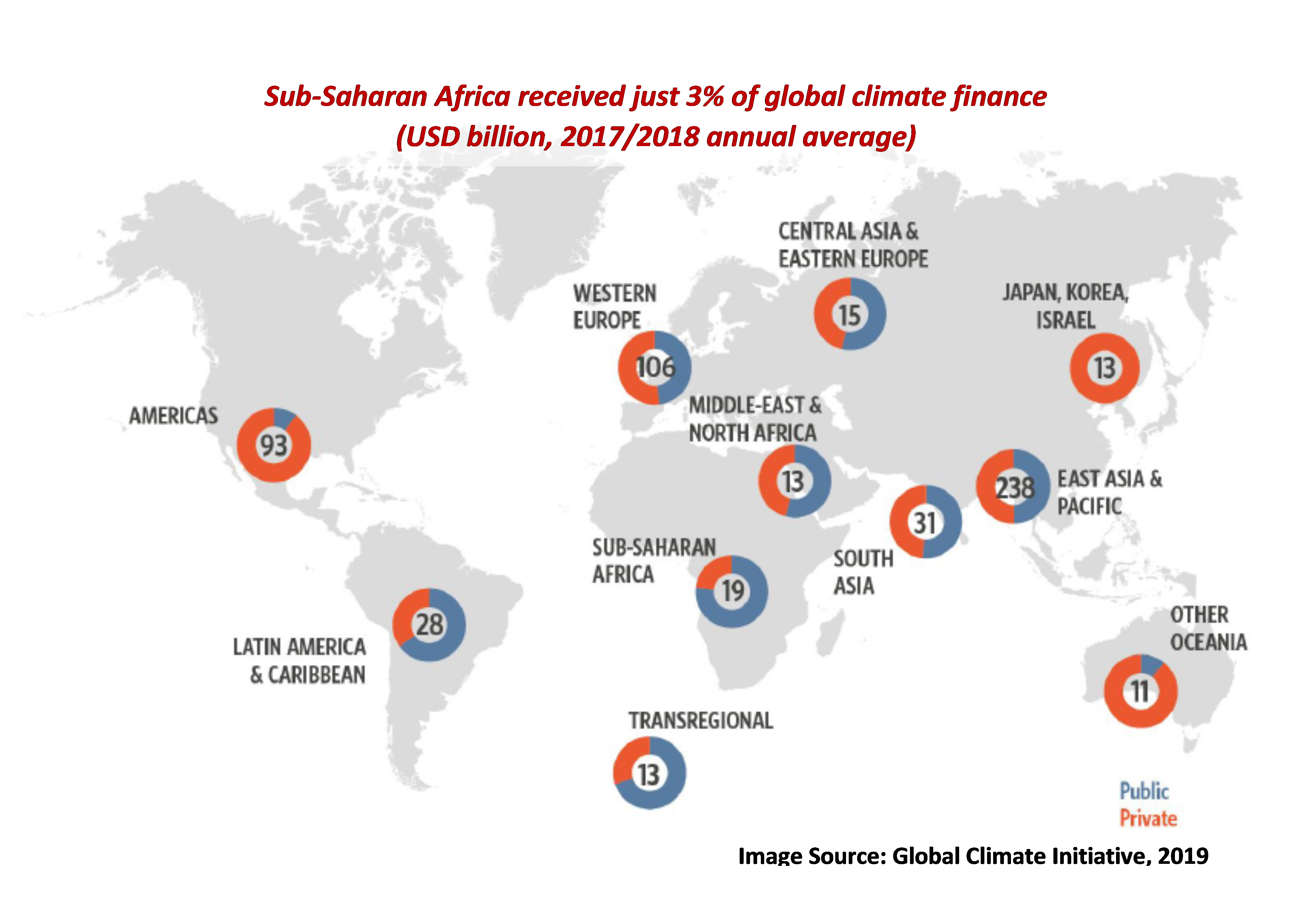
Article written by Ijeoma Ozulumba Doris with support from her teacher Chris Ahlfeldt as part of the Environmental Finance Course with the University of Stellenbosch Business School.
The Need for Green Finance in Africa
The increased emission of Greenhouse Gases (GHGs) through human activity in the energy, agriculture, land use, transport, and manufacturing industries has led to changes in the earth’s climate, notably the rise in global temperatures, rising sea levels, higher ocean temperatures, and shrinking sea ice. With an increase in human population and activity, this is now further accelerated, resulting in extreme weather events such as droughts and wide variations in precipitation, wreaking havoc on lives and livelihoods across the world.
While Sub-Saharan Africa contributes little to global emissions (although this is growing due to population growth and industrialization), Africa is, and will be, most affected by climate change by way of increased water scarcity, increased mortalities related to climate change, and the deterioration of already fragile economies. In addition, Africa has a reduced capacity to deal with these due to weak infrastructure and lack of accessible finance.
In addition to the severe socio-economic developmental deficit in Sub-Saharan Africa, the region may face additional pressures from desertification, food shortages, flooding, insecurity, and climate migration if urgent steps are not taken.
To combat the effects of climate change, 195 countries have signed the Paris Agreement which was developed in 2015 as a declaration to galvanize action towards reducing GHG emissions and limiting the global temperature rise to 2oC above the preindustrial average temperature. To achieve this, each country agreed to a set of Nationally Determined Contributions (NDCs) which sets out targets and benchmarks for GHG emissions, policies, and measures to be taken by each country to meet the Agreement.
In addition to the Paris Agreement, climate action is the 13th goal in the 17 Sustainable Development Goals (SDGs) which were adopted by all United Nations Member States in 2015 as a universal call to end poverty, protect the planet, and ensure that all people enjoy peace and prosperity by 2030.
While a holistic approach to climate action including creating awareness, developing partnerships, market development, and capacity building are required, access to finance remains a major challenge in Africa combating the effects of climate change.
Understanding the Scope of Green Finance
One major financing solution that can assist Africa with these challenges is Green Finance, a concept of Sustainable Finance that takes into account Environmental, Social, and Governance (ESG) considerations. The G20 (Green Finance Study Group) defines it as financing of investments that provides environmental benefits in the broader context of environmentally sustainable development. According to the United Nations Environmental Programme (UNEP), green financing is increasing the amount of financial flows (from banking, micro-credit, insurance, and investment) from the public, private and not-for-profit sectors to sustainable development priorities.
Financing the Sustainable Development Goals requires a large amount of funds. The Climate Policy Initiative estimated that over $1.6 to $3.8 trillion in new climate investment is required annually until 2050 to achieve climate objectives. In the last 5 years, Green Finance has become more popular with public and private sector actors playing key roles in mainstreaming this finance source.
Sources, Instruments, and Uses of Green Finance
Sources of Green Finance are predominantly governments, development finance institutions, commercial banks, and institutional investors. As the nature of green projects is usually long-term, there is a need to match this requirement to the availability of long-tenored funding along with affordable pricing. In recent years, Impact Investing, or “investments made with the intention to generate a measurable and beneficial social or environmental impact alongside a financial return” has gained traction in this area. An Impact Investor will be able to provide patient capital and accept a lower return on investment in return for a measurable environmental impact. Institutional investors such as pension funds, insurance companies, sovereign wealth funds, and foundations/endowments form an increasingly important bloc of impact investors who bring a lot of market discipline to the space.
The World Bank is the world’s largest financier of climate action, and over the next 5 years, 35% of financing will have climate benefits while 50% of climate financing will focus on adaptation. In addition to increasing climate finance, the World Bank will aid nations in implementing their NDCs as well as measure results and impacts. Along with the World Bank, The Green Climate Fund was created to support the efforts of developing countries in responding to the effects of climate change. Unfortunately, it has remained underutilized by Sub-Saharan Africa on account of the lack of capacity and of projects to be financed.
Instruments deployed in Green Finance are usually debt, equity, grants, guarantees, and securitization. Debt has a disproportionately large share of financing options due to flexibility and ease of use, and it comprises mostly green bonds and green loans which must meet stringent requirements on the use of proceeds, project evaluation, project management, and reporting. Project finance plays an important role in Green Finance as funders seek to take advantage of the unique risk management advantages of project finance in view of large capital outlay, untested technology, and long tenor of projects such as solar and wind energy or rail development. Apart from these factors, Steffen (2018) showed how for certain types of deals, project finance has much greater importance for renewables than for fossil fuel-based power plants. Other innovative instruments of Green Finance include guarantees (especially from large multilaterals like MIGA and AGF) results and interest rebate grants, securitization (packaging of small loans to investible funds) and carbon financing.
Lastly, the majority of Green Finance has found uses in renewable energy and transport sectors as well as land use and water/waste systems. These areas have a considerable multiplier effect and can be of immense benefit in Africa considering the energy shortage in many locations and severe lack of transportation infrastructure.
Opportunity Exists in Various Sectors
As previously mentioned, climate change will disproportionately affect Africa for the worse compared to the rest of the world. It is therefore important for Africa to be a major contributor to climate action by replacing carbon-intensive energy sources and forestalling becoming a major emitter in the future due to its rapid population growth.
The high cost of energy continues to affect Africa’s ability to create decent work and reduce dependency on imports. There is a severe energy shortage, and current electricity deployment is inefficient. The opportunity to utilize renewable energy, especially solar where Africa has a clear proclivity, is also enhanced by the continuous reduction in their levelised costs of energy as compared to fossil fuels. This need is also underscored by the importance of energy access for Africa in promoting agriculture, food security, and forestalling instability. Clean energy is just one sector with significant potential on the continent for green finance, while others like agriculture, transport, and water security will also require considerable funding over the coming decades.
Overcoming Challenges to Deployment
Despite the large need, Green Finance in Sub Saharan Africa has been limited compared to the rest of the world.
While developing nations will be most affected by climate change, they unfortunately face significant challenges in efficient deployment of capital. These include under-developed financial and environmental regulations, high levels of informality in the economy, illegal activities and reduced law enforcement, lack of information, and high transaction costs. In addition, climate projects are usually long-term for which capital is not readily available as investors evaluate the associated sovereign risks of each country.
Overall, there is a lack of sizable foreign capital in green growth on the continent that can be deployed easily and at amounts that match local demand. Schwerhoffa and Sy (2017) echoed this in the conclusion of their research on financing the SDGs that there is a lot of untapped potential in Africa to mobilize funds for sustainable finance. Hopefully this funding can be scaled-up further with potential commitments from COP26.
Actions Required to Unlock Green Finance in Africa
For any meaningful impact to be made on climate action in Africa, funding to the sector needs to increase. The following measures can help facilitate enhanced capital flows to Sub-Saharan Africa.
- De-risking mechanisms should be put in place by governments to attract investors and create private sector involvement on the supply and demand side. This includes uses of policy, incentives, and measures which can be directive-based, price-based or information-based. Policies should incentivise Green Finance and discourage carbon-intensive investments.
- Use of innovative financing instruments including debt-for-nature climate swaps, green bonds, and securitization. Appropriate instruments should be deployed depending on project characteristics and the peculiarity of the market geography. A blend of instruments could also be applied to a particular deal or fund.
- Enhance capacity in project finance and public-private partnerships as a mechanism for leveraging public funds, risk management, and reducing inefficiencies and bureaucratic bottlenecks. In particular, developing the capacity to access and evaluate green projects and the associated climate risks they would mitigate.
- Develop domestic financial markets and institute fiscal discipline for enhanced credit ratings. Information has become increasingly available with many companies now issuing sustainability reports. A comprehensive database of the demand and supply side of global Green Finance is critical for identifying where opportunities exist and where learnings from other jurisdictions could be applied. Schwerhoffa and Sy (2017) further highlighted the need to improve local markets to achieve critical mass for financing Green projects
- Form a strong coalition of all stakeholders including governments, development financial institutions, and the private sector. Of the $579bn reported by the Climate Policy Institute in 2017/2018, 56% came from the private sector, but more is needed if the public sector wants to sufficiently scale its impact. Regional governments can potentially scale-up and allocate resources to climate action as a means of catalysing additional funding from the private sector.
- Impact measurement, analysis, alignment of targets to the SDGs and the NDCs, including appropriate disclosure of achievements, gaps, and future plans are required to ensure all stakeholders are in alignment with the region’s climate goals.
- Capacity building on definitions, frameworks, methodology, and financial expertise on developing innovative and unique solutions for Africa’s Green Finance models.
There is an urgent need for Sub Saharan Africa to activate climate action as current vulnerabilities expose the region to even more threats of the effects of climate change. Presently an insufficient amount of financing has been made available and deployed in this region to meet the Sustainable Development Goals. Hopefully this funding can be scaled-up further with potential commitments from COP26 in Glasgow and as institutional goals on climate change. Likewise, the Covid-19 pandemic could also increase the investment in Green Bonds related to stimulus and recovery for countries. Both the public and private sector have an opportunity to work together to deploy existing sources, instruments, and uses of Green Finance in innovative and tailor-made ways to enhance funding for climate action in Africa.

References
- Climate Bonds Initiative Brief https://www.climatebonds.net/files/files/cbi-sustainable-debt-global-sotm-h12020.pdf Accessed on 31 March 2021
- Climate Policy Initiative Updated View on the Global Landscape of Climate Finance 2019 Rob Macquarie, Baysa Naran, Paul Rosane, Matthew Solomon, Cooper Wetherbee and Barbara Buchner December 18, 2020 https://www.climatepolicyinitiative.org/wp-content/uploads/2020/12/Updated-View-on-the-2019-Global-Landscape-of-Climate-Finance-1.pdf Accessed on 2 April 2021
- Schwerhoff, G., & Sy, M. 2017. Financing renewable energy in Africa–Key challenge of the sustainable development goals. Renewable and Sustainable Energy Reviews, 75, 393-401.
- Steffen, B. 2018. The importance of project finance for renewable energy projects. Energy Economics, 69, 280- 294
- Harold J., Spitzer J., Emerson J., Spence M Environmental Impact Investing (2017) in Social Finance Ed Nicholls A, Paton R. and Emerson J., 2017, Social Finance. PP: 589 – 615. Oxford Press


